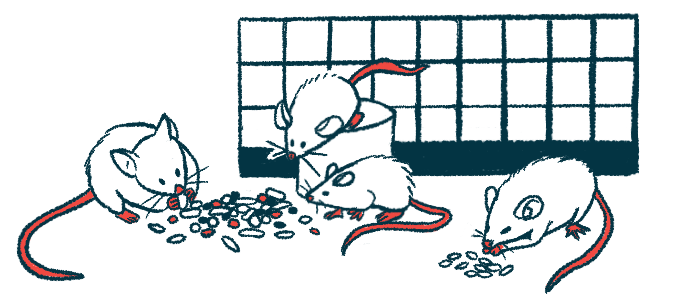Mouse Study Uncovers Sex Differences in CLN8 Disease Severity
Female mice showed worse behavioral deficits and shorter lifespan
Written by |

Female mice with Batten disease caused by a mutation in the Cln8 gene had greater disease severity, including worse behavioral deficits and a shorter lifespan, than their male counterparts, a study has found.
These female mice also had more activation in the brain of microglia, a type of cell that drives inflammation. Researchers hypothesize that this increased inflammatory state might underlie the observed differences in disease severity.
Still, male and female mice responded equally well to a gene therapy designed to provide a healthy copy of Cln8.
“Based on the surmounting body of evidence demonstrating the importance of sex as a biologic modifier, … analysis of sex differences in other forms of Batten disease should be conducted to yield a better understanding of disease [mechanisms] and treatment response,” the researchers wrote.
The study, “Sex-split analysis of pathology and motor-behavioral outcomes in a mouse model of CLN8-Batten disease reveals an increased disease burden and trajectory in female Cln8mnd mice,” was published in the Orphanet Journal of Rare Diseases.
Mutations in the CLN8 gene lead to a rare form of late-infantile Batten disease, with symptoms typically emerging from ages 5 to 10, and including loss of vision, motor and cognitive deficits, and seizures.
As with other types of Batten, CLN8 disease is caused by the toxic buildup of insoluble waste deposits — called lipofuscins — inside cells’ recycling centers, which leads to abnormal activation of glial cells, and neurodegeneration.
Glial cells such as microglia and astrocytes are non-neuronal cells that provide support and protection to nerve cells, but their abnormal activation has been shown to be a driver of neuroinflammation.
In recent years, a number of studies have reported that biological sex may influence disease outcomes for some forms of Batten.
A previous study in a mouse model of CLN8 disease found that the eyes of female mice were affected more severely than the eyes of male mice. Yet, no other studies have examined other potential differences in disease expression between sexes for this Batten type.
Evaluating influence of sex in mice
Now, a team of researchers in the U.S. aimed to evaluate the influence of sex on behavioral outcomes and brain changes in a mouse model of CLN8-Batten.
The mice demonstrated the progressive accumulation of lipofuscins and other waste products in the brain, as well as marked activation of glia cells — a process called gliosis. But the researchers identified differences in these disease features by sex, brain region, and time points.
Male mice showed earlier and more severe waste product accumulation than female mice. However, this sex-specific difference “disappeared at later time points,” the team wrote, which may suggest that the onset of disease-associated mechanisms is earlier in males, but females show faster accumulation progression.
In addition, female mice demonstrated exacerbated microglia activation in multiple brain regions, which emerged sooner than it did in male mice. Females also had greater astrocyte activation in some brain regions relative to males.
Overall, female mice showed a “consistent upregulation of astrocyte and microglia reactivity in several regions of the brain that is more severe than their male counterparts,” the researchers wrote.
The mouse model of CLN8 disease showed a shortened survival compared with healthy mice, with a median lifespan of 10 months. Notably, survival was significantly shorter in female mice, which lived an average of 0.5 months less than their male counterparts.
Female mice also demonstrated more tremors and worse performance in a test of spatial learning at earlier stages than male mice. The latter may be associated with greater memory, learning, or visual deficits.
These findings highlight that female mice with CLN8-Batten-like disease “consistently show a significantly faster and more severe disease progression than their male counterparts,” the researchers wrote.
Lastly, the researchers aimed to investigate whether sex had an impact on the response to gene therapy.
The team previously had developed a gene therapy designed to deliver a healthy copy of the Cln8 gene to the mouse model, and demonstrated that the treatment improved the animals’ lifespan and eased behavioral and cellular abnormalities.
In the new experiments, data showed there were overall minimal sex differences in treatment response regarding waste product accumulation, gliosis, motor deficits, and survival.
However, female mice still performed worse in a spatial memory test, but “it is unclear if this is due to an altered response to treatment or simply due to the trajectory of disease in a typical female animal,” the researchers wrote.
Microglia activation
The team hypothesized that more severe gliosis, particularly microglia activation, in the female mice may drive greater inflammation and disease severity, noting that “an increasing body of evidence” implicates these cells in Batten-associated neurodegeneration.
As to why this process is different in males and females is a question that warrants further investigation, the researchers noted.
Still, “these sex-dependent murine model differences cannot be correlated with clinical outcomes in humans since there have been no such detailed human investigations,” the researchers wrote, adding that sex discrepancies have been reported only in people with juvenile Batten disease, the most common form.
The small patient populations, as well as environmental and genetic differences, make it difficult to study the issue in humans, the team noted.





